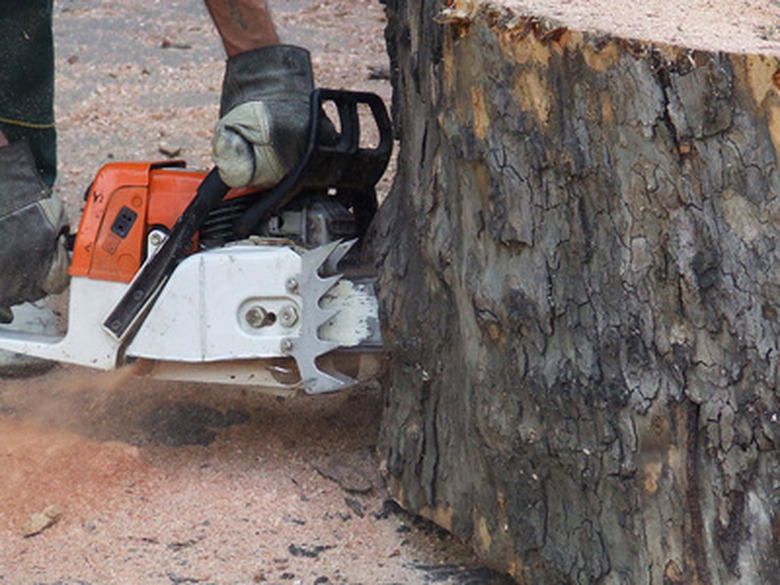How To Tune A Husqvarna Chainsaw
Things Needed
-
Flathead screwdriver
-
Tachometer
Tune a Husqvarna chainsaw regularly to ensure good performance and prevent damage caused by an irregular engine. Three screws on the carburetor are used to fine tune the engine to ensure smooth operation. The "H" screw is used for adjusting the saw's RPMs when at high throttle, while the "L" screw controls low throttle operation in addition to when the saw is rotating up to speed. The third screw, which is often labeled as a "T," is used for setting the idle speed when the saw is running, but has no throttle applied.
Step 1
Check the air filter to ensure it is not plugged with sawdust or any other material. Also, inspect the muffler for any buildup of carbon. Finally, ensure that the fuel tank is over half full, as leaving any of these issues unaddressed could result in an overly rich fuel mixture after adjustment.
Step 2
Start the engine and let it idle for several minutes to allow it to warm up. If the saw cannot idle without stalling out, repeatedly squeeze the throttle to keep it running as long as you do not race the engine to full throttle. Doing so while the engine is still cold or in the process of warming up could cause serious damage.
Step 3
Attach the tachometer to the saw. During all steps, keep track of the RPMs and do not ever exceed the recommended revolutions as outlined in your operator's manual. For most Husqvarna saws, the recommended idle speed is 2700 RPMs, but consult your specific manual to be certain.
Step 4
Adjust the idle speed of the saw using a flathead screwdriver on the "T" screw. Tightening the screw decreases the richness of the fuel mixture, while loosening it has the opposite effect. You want the saw to run smoothly without stalling, but not to have the RPMs so high that the chain engages while it is running idle.
Step 5
Adjust the "L" screw by slowly tightening it until the engine begins to surge or starve for fuel. Note the position and loosen the screw the other way until the engine starts to bog or drown from an overly rich fuel mixture. Take note of this position and tighten the screw again until the saw is idling comfortably, most likely somewhere directly between the two settings.
Step 6
Return to the "T" screw and adjust it again, as there is a chance that adjusting the "L" screw may have changed the optimized fuel settings at idle speed.
Step 7
Give the saw full throttle and adjust the "H" screw, tightening it until the engine begins to starve, then loosening until it starts to bog down. Find a comfortable setting between these two points where the saw runs smoothly.
Step 8
Release the throttle and check the "L" screw setting again, making any readjustments that are necessary.
Step 9
Return to the "T" screw and adjust the idle speed one final time. This time tighten the screw until the saw is running smoothly, but does not stall out on you. This is your final idle setting, and the saw is now ready for work.
Tip
While it is quite possible to tune a chainsaw by ear, having a tachometer available will make your work much more precise, and help you avoid exceeding recommended RPMs. (Reference 1)
In addition to normal maintenance, your chainsaw will need to be tuned if you are going to be operating it at higher altitudes, as this can affect the fuel mixture settings.
Warning
The seating for the screws can be delicate in some chainsaws, so ensure you do not exert too much force while turning them. A screw with a broken seating will result in requiring a whole new carburetor to be purchased.
It is very dangerous for the chain to be engaging in movement while the saw is sitting at idle speed.
